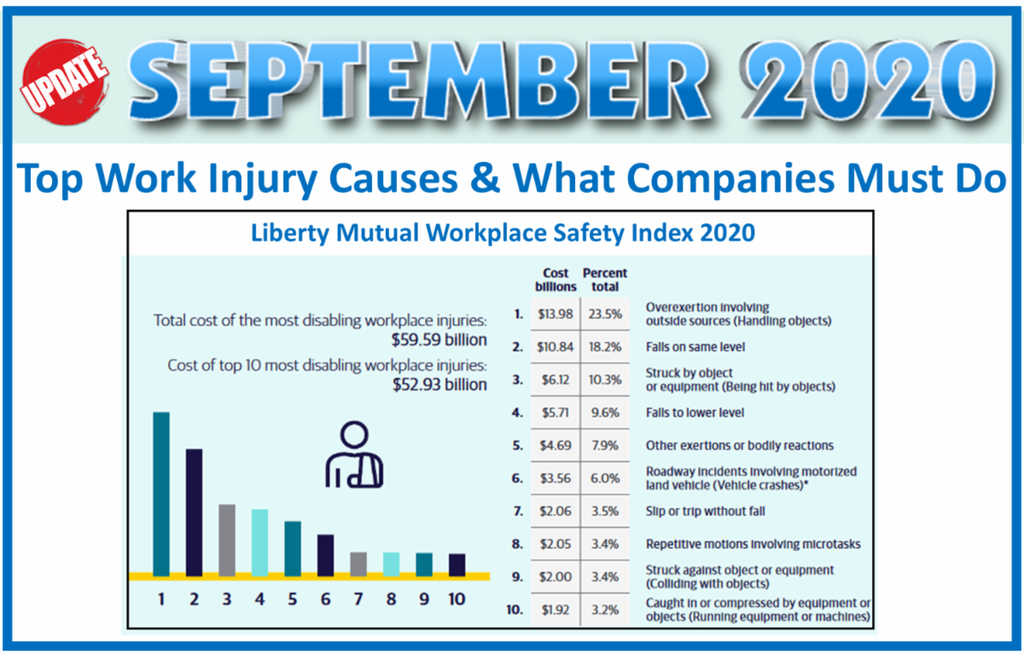The annual Workplace Safety Index ranks the top 10 causes of disabling work-related injuries and we tell you how you can ensure you aren’t part of these statistics. Liberty Mutual’s 2020 Workplace Safety Index finds that serious, nonfatal workplace injuries amounted to nearly $60 billion in direct U.S. workers compensation costs. This translates into more than a billion dollars per week spent by businesses on these injuries. In fact, the top 10 causes of workplace injuries account for more than $50 billion or 89% of the total cost.
- OVEREXERTION INVOLVING OUTSIDE SOURCES Injuries from lifting, pushing, pulling, holding, carrying, or throwing objects accounts for 23% of the national burden when it comes to workplace injuries. TAKE ACTION: Train employees on the proper way to perform the physical tasks required on the job. Utilize equipment, instead of manual labor, when available. Ensure employees are provided breaks and rest when needed to prevent overexertion.
- FALLS ON SAME LEVEL Slips, trips and falls are one of the most common causes of workplace injuries indoors and outdoors. Employees are at risk for sprains, strains, lacerations or worse especially if they fall into surrounding debris that could cause further injury. TAKE ACTION: Ensure non-slip mats and rugs are in use, make good housekeeping a priority in the workplace, repair or clearly mark uneven walking surfaces and train employees on proper clean-up requirements.
- STRUCK BY OBJECT OR EQUIPMENT When work is done at heights, large equipment is in use, or materials are stored vertically there can be a great risk for employees to be struck by falling objects or moving equipment. TAKE ACTION: All overhead materials should be stored in a secure manner. Caution signs should be used and proper PPE, like hard hats, should be in used when needed.
- FALLS TO LOWER LEVEL Falls from heights can be from ladders, through floor holes or sky lights, from scaffolding, on stairways, from roofs or from large equipment. TAKE ACTION: Ensure all employees that work at heights have proper fall protection provided and they are trained on the use of the fall protection equipment including PFAS, guardrails or other engineered devices.
- OTHER EXERTIONS OR BODILY REACTIONS These injuries are typically non-impact but occur when a body reacts or responds to something unexpected or has an injury due to a vigorous or strenuous effort. These injuries don’t fit into one of the other common categories. TAKE ACTION: Workplace risk assessments can help evaluate common hazards that employees may be exposed to and assist management with prevention and training opportunities.
- ROADWAY INCIDENTS INVOLVING MOTOR VEHICLE Employees who drive for business purposes may have more opportunity to be injured in auto crashes and are also susceptible to distracted and drowsy driving. TAKE ACTION: Define safe driving policies with an emphasis on distracted, drowsy, and defensive driving. Provide employees with safe-driver training.
- SLIP OR TRIP WITHOUT FALL Reaction injuries occur when an employee slips or trips but doesn’t fall down. The stress of the reaction to correct the body to upright can cause muscle strain, twisted ankles, or other trauma. TAKE ACTION: Place no-slip rugs near entrances/exits, make sure any uneven areas are labeled clearly (or repaired), keep all work spaces tidy and potential slippery areas around the building outside should be cleared.
- REPETITIVE MOTIONS INVOLVING MICRO-TASKS Working on the computer or performing the same task on the assembly line day after day can strain muscles and tendons which may cause back pain, vision problems and carpal tunnel syndrome. TAKE ACTION: Employers should provide, and employees should advocate for proper ergonomic equipment and training. Employees should be encouraged to take breaks and a job rotation schedule along with cross-training could be considered.
- TRUCK AGAINST OBJECT OR EQUIPMENT When employees unintentionally walk into equipment, walls, debris, or furniture in the workplace it is common to have head, knee, neck and foot bruising, sprains, and injuries. TAKE ACTION: Ensure good housekeeping is a priority in the workplace, walkways are designated, and potential hazards are clearly marked.
- CAUGHT IN/COMPRESSED BY EQUIPMENT OR OBJECTS Caught-in injuries are one of the top 4 serious incidents that occur in construction and machine entanglement caught-in injuries occur most often in factory settings. TAKE ACTION: Provide protective barriers and train employees on how to recognize caught-in hazards.
CalWorkSafety & HR Is Here To Help:
NEED A FRESH IDEA FOR A SAFETY MEETING TOPIC? This Top 10 List is a great place to start. Review the entire list if you have more time and encourage discussion about the potential hazards found in your own workplace that might fall into each category.
SHORT ON TIME? Pick any one from the top 10 list that applies to your current work environment and focus on ways management and employees can prevent injuries and keep workers safe.
HERE’S THE SOLUTION: CalWorkSafety & HR greatly appreciates that our clients consistently take a “#Safety-First” approach.
Contact your consultant or email: dondressler@calworksafetyhr.com
Achieve Business Profitability … Reduce Costs … Mitigate Risks Discover the extensive training courses we offer our clients.Contact us today – we are here to help!
